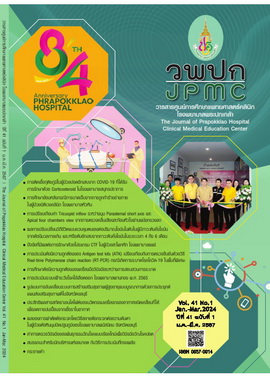Dengue Fever Surveillance System Evaluation at Phanthong Hospital 2022
Main Article Content
Abstract
BACKGROUND: Dengue fever is a significant public health problem in Thailand. There is a seasonal outbreak pattern that can be found throughout the year. Thus, an effective surveillance system is required. The situation of the COVID-19 pandemic has impacted the strength of disease surveillance. Therefore, the disease surveillance system was evaluated to check whether the system remains strengthened.
OBJECTIVES: To study the disease reporting process of the surveillance system, quantitative and qualitative characteristics were evaluated, and ways to develop the dengue fever surveillance system were determined.
METHODS: A cross-sectional descriptive approach was used by reviewing the medical records of patients who were diagnosed with dengue fever and similar disease groups from 1 January to 31 December 2022 and interviewing personnel via the created questionnaire. The data were analyzed using descriptive statistics and content analysis.
RESULTS: A total of 91 patients met the disease criteria, and 60 patients were reported in the surveillance system. It was found that the sensitivity of disease diagnosis was 65.9% and the accuracy of disease reporting or predictive positive value was 95.2%. The information in the surveillance system was recorded completely at 100%. The gender and age variables were correct at 100%, while the address at the time of illness was correct at 82.5%, and the date of illness onset was correct at 63.5%. The reporting data matched and could be representative. Cases were reported in a timely manner. Executives accepted and gave importance to using data to continuously monitor and supervise work. The staff understood the system and had backup staff. Disease codes were updated according to defined provisions. The hospital had a patient care system during official time, out time and emergency. The budget was sufficient.
CONCLUSIONS: The surveillance system reporting process follows provincial guidelines. All quantitative and qualitative characteristics were within acceptable limits. The results of the study could be used to develop the strength of disease surveillance, prevention and control in the area.
Article Details

This work is licensed under a Creative Commons Attribution-NonCommercial-NoDerivatives 4.0 International License.
References
Department of Disease Control. Dengue fever [Internet]. 2022 [cited2023Jan9]. Available from: https://ddc.moph.go.th/disease_detail.php?d=44
Department of Disease Control. Dengue fever situation [Internet]. 2022 [cited 2023 Jan 9]. Available from: https://lookerstudio.google.com/reporting/84a91f26-9f99-4d85-aa9c-9f2f42205a77/page/p_ig9kzdzrpc
Chonburi Provincial Public Health Office. Communicable disease registry (E0 registration) from program R506. 2022 [cited 2023 Jan 13].
Department of Disease Control. Case definition for communicable diseases surveillance. Nonthaburi: Division of Epidemiology; 2020.
German RR, Lee LM, Horan JM, Milstein RL, Pertowski CA, Waller MN, et al. Updated guidelines for evaluating public health surveillance systems: recommendations from the Guidelines Working Group. MMWR Recomm Rep 2001;50(RR-13):1-35.
Plipat T. Public health surveillance. In: Ungchusak K, Sawanpanyalert P, Sawatdivuthipong W, Jiraphongsa C, editors. Basics of epidemiology.3rded. Bangkok: Canada Graphics; 2019. p. 142-77.
Naettip S, Tamwong A. Dengue surveillance evaluation at Wangnuea Hospital, Lampang Province, Thailand during 2018–2020. Weekly Epidemiological Surveillance Report 2022;53: 453-61.
Junnate W, Jotking T. evaluation of dengue surveillance system in Soengsang hospital, Nakhon Ratchasima province, Thailand, 2017. Weekly epidemiological surveillance report. 2019;50:549–55.

